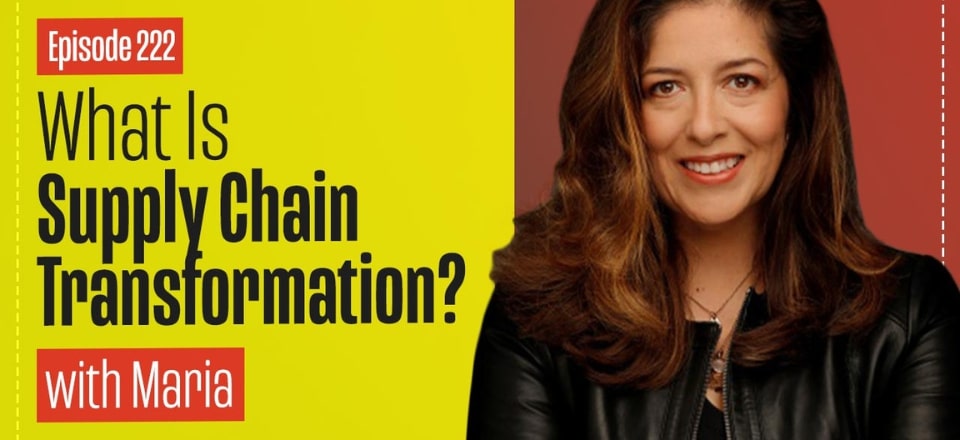What are the key drivers behind Supply Chain Transformation?
How does this transformation impact both people and organizations?
Watch the video below as expert Maria Villablanca breaks down the essential elements of supply chain transformation and its broader effects.
Gain insights from a leading professional in the field.
Rob: Welcome to the channel! Today, we’re diving into the topic of supply chain transformation. To get a deep understanding of this concept, we have Maria Villablanca with us, an expert in the field. Maria, thanks for joining us!
Maria: Thanks for having me, Rob! It’s great to finally connect in person. We’ve been connected on LinkedIn for a while, but it’s exciting to have this conversation directly.
Defining Supply Chain Transformation
Rob: Absolutely. I know supply chain transformation is one of your key areas of expertise. For those who may not be familiar with the term, can you break it down for us? What does it really mean and what should people know about it?
Maria: Sure, Rob! Let’s start with some context. About 15 years ago, there was a lot of talk about digitization and digital transformation. Large companies had many processes that were analog—using Excel spreadsheets and paper forms. This lack of digital integration meant poor visibility and inefficiencies.
As we moved forward, especially around the time of the pandemic, the focus shifted from just digital transformation to a broader supply chain transformation. Unlike a simple linear chain, today’s supply chain is more like a complex network with multiple suppliers and distribution centers.
Supply chain transformation now involves a comprehensive rethinking of processes, mindset, and business models. Companies have to adapt to constant crises, changes in consumer behavior, rapid technological advancements, and sustainability concerns.
Key Areas of Supply Chain Transformation
Rob: That’s a great overview. So, what are some key areas where businesses are focusing their supply chain transformation efforts?
Maria: One major area is digital integration. Companies are moving away from outdated and labor-intensive practices. They’re embracing advanced data analytics and technologies like generative AI, which provide faster and more accurate insights. This leads to better decision-making and enhanced transparency.
Another crucial area is business model transformation. Many companies are shifting from traditional wholesale models to direct-to-consumer approaches. This change, driven by the rise of e-commerce and new consumer expectations, represents a fundamental shift in how businesses operate.
Sustainability is also a significant factor in supply chain transformation. For example, Coca-Cola has redesigned its bottle caps to stay attached, which reduces waste. This kind of transformation involves not just design changes but also adjustments in production processes and sourcing.
Adapting for Smaller Businesses
Rob: Interesting! If someone is running a smaller business, how can they tell if they need to embrace supply chain transformation?
Maria: Great question! Supply chain transformation is not just for large corporations. Small and medium-sized businesses also need to adapt. Regulations are becoming stricter globally, and even small suppliers need to comply with transparency and sustainability standards. For instance, a small vanilla bean farmer in Madagascar may supply large companies, so they need to have digital practices in place to meet these requirements.
Common Mistakes in Transformation
Rob: Understood. What are some common mistakes companies make when undergoing supply chain transformation?
Maria: One common mistake is trying to overhaul everything at once. Transformation should be gradual and targeted. Start with specific areas like procurement or data management and make improvements incrementally.
Another issue is the “shiny new object” syndrome. Companies often invest in the latest technologies without addressing underlying problems. The key is to identify specific issues and focus on solving them to enhance the overall efficiency and effectiveness of the supply chain.
For detailed insight in Supply Chain Transformation, watch the video above.
Connect with Maria here:
YouTube: https://www.youtube.com/@MariaPVillablanca
Website: https://www.mariavillablanca.com/
Linkedin: https://www.linkedin.com/in/mariavillablanca/
And listen to Maria’s podcast here: https://podcasts.apple.com/gb/podcast/transform-talks-the-supply-chain-transformation-podcast/
Related articles on this topic have appeared throughout our website, check them out:
- Future Supply Chain Insights from Pro-to-know, Sheri Hinish
- These Three Technologies are Hot, But Are Supply Chains Adopting Them?
- Supply Chain and the Internet of Things – Towards New Paradigms
- Change Leadership: The Real Key to Transforming Your Supply Chain
- 6 Steps to Sustainable Supply Chain Reality
Editor’s Note: The content of this post was originally published on Logistics Bureau’s website dated February 14, 2024, under the title “Understanding Supply Chain Transformation with Maria Villablanca“


